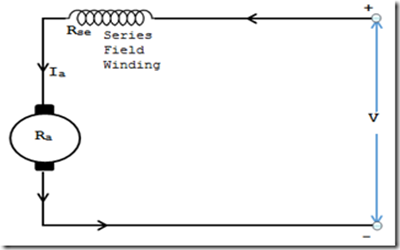
Armature current and mechanical load
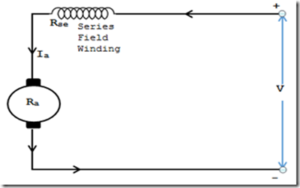
Armature torque V S Armature current
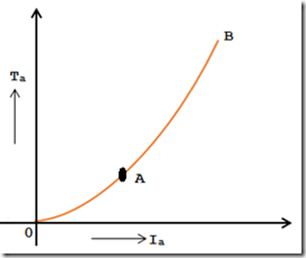
Up to magnetic saturation Φ ∝ Ia, the armature torque Ta is directly proportional to the square of the armature current (i.e. T A ∝ I 2 A ). When the armature current doubles, the armature torque increases almost four times. Thus, the curve of armature torque versus armature current up to magnetic saturation is a parabola, which is shown in the characteristic curve OA. On the other hand, once magnetic saturation is reached, T A is directly proportional to I A . As a result, the characteristic of armature torque versus armature current magnetic saturation is a straight line, shown in curve AB.
From this curve, we understand that the starting torque of DC series motor is higher compared to DC shunt motor. We know that T A ∝ Φ (i.e.) series motor (T A ∝I2 A ) > Shunt motor (T A ∝ IA ).
Characteristics of a DC series power generator
DC series wound or series wound generators are widely used electrical machines that convert mechanical energy into electrical energy. These generators have unique characteristics that make them suitable for specific applications. This section examines the main elements of DC series generators and their importance in various industries.
Output voltage regulation
One of the special features of DC series generators is the ability to regulate the output voltage. As the load connected to the generator increases, the armature current increases, increasing the magnetic field created by the armature windings. This enhanced magnetic field results in a higher back electromotive force (EMF) and a higher voltage generated. This inherent voltage regulation makes DC series power generators suitable for applications that require constant voltage levels, such as: B. Battery charging systems and industrial machines.
High starting torque
DC series generators are known for their high starting torque, which allows them to power large loads at start-up. The series field winding connected in series with the armature provides a high magnetic field intensity, allowing the generator to produce significant torque. This property makes DC series generators suitable for applications such as electric drive systems, where starting torque is crucial for accelerating vehicles or heavy machinery.
Adaptability to variable loads
DC series generators have excellent adaptability to variable loads. As the load connected to the generator changes, the armature current adjusts accordingly, resulting in a corresponding change in the voltage produced. This adaptability makes DC series generators suitable for applications with varying load requirements, such as: For example, electric locomotives, cranes and elevators.
Limited overload capacity
DC series current generators have limited overload capability due to the relationship between the armature current and the field winding. When the load connected to the generator exceeds its rated capacity, the armature current increases significantly, resulting in an increase in the magnetic field intensity. However, this increase has a practical limit, as excess armature current can cause magnetic saturation and overheating in the windings. Therefore, DC series power generators are generally designed to operate within their rated capacity to ensure safe and reliable performance.
Simple construction and cost-benefit
Series DC current generators have a relatively simple design consisting of a series field winding, an armature winding, and a commutator. This simplicity contributes to its cost-effectiveness compared to more complex generator designs. The simple design also makes DC series generators easier to maintain and repair.
Current characteristic of speed armor
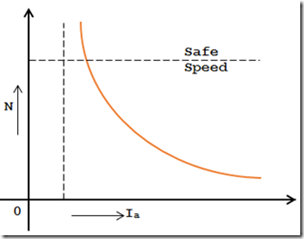
We know that the posterior emf E b =VI A (R A +R se ).
As soon as I A the back emf E increases b is reduced by a fall in I A (R A +R if ), even though the flux is increasing. Despite this, A (R A +R se ) is smaller under normal circumstances and can be vomited.
Therefore N ∝ (1/ Φ). The armature current-velocity characteristic follows the hyperbolic curve until magnetic saturation {∝ (1/ Φ)}. The flow then remains constant and thus guarantees the speed.
The figure above shows the circuit diagram of a series motor. In a series wound motor, current flows equally in the field winding and armature. The armature current increases as the mechanical load on the motor increases. As a result, the flux in the series motor increases as the armature current increases and vice versa.
Speed armature torque characteristic
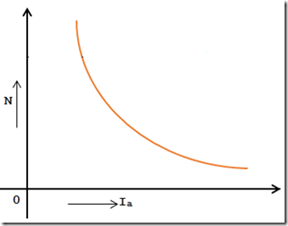
DC motor voltage equation and power equation
From the above three characteristics of a series engine, we can derive the three important points.
- The starting torque of a series motor is high because initially T A ∝ L 2 A .
- The series motor operates at variable speed because it automatically adjusts speed when the load changes.
- When idle, the armature current is very low, as is the flux. As a result, the series motor speed is very high. This is very dangerous for machines, which can be damaged due to the centrifugal forces generated in rotating parts. Therefore, the series engine must not be started at idle speed. The series motor must always be started with minimum load to keep the speed within limits.
Conclusion
Furthermore, the constitutional speed control characteristics of DC motors allow the operating speed to be changed seamlessly, providing precise control and adaptability to diverse working conditions. Its simple, reliable design has stood the test of time and secured its place as a cornerstone of electric motors.

